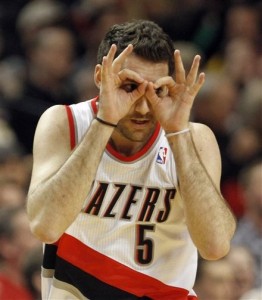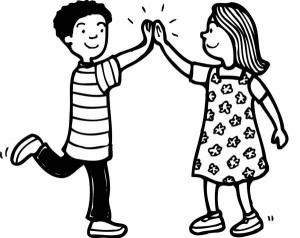Monday, March 31, 2014 1:47 am
Roland Barthes defines semiotics as “the study of the social production of meaning from sign systems; the analysis of anything that can stand for something else” (332). Signs are made up of two separate parts: the signifier and the signified. The signifier is the actual image of the sign and the signified is the meaning that comes with the sign. When reading about semiotics, I thought of the handshake. Originally, the handshake was created for soldiers in order to show each other that they did not have a weapon on them; the handshake was used to signify peace. Overtime, however, the handshake has become a sign for several things. It is a sign of greeting or welcoming, agreement, and congratulations. Additionally, it is a sign of good sportsmanship when playing sports. When two people shake hands, it comes with a reason and has meaning. Furthermore, the type of handshake also has meaning. If it is strong, then the person knows that the meaning behind it is genuine. However, if a person gives a handshake that is weak and does not make eye contact, the other person will assume that it is not genuine. For example, if you lose a tennis match and shake your opponent’s hand weakly and without eye contact, they will assume that you have bad sportsmanship.

Monday, March 31, 2014 1:15 am
Semiotics, or semiology, as described by Roland Barthes, is the “study of the social production of meaning from sign systems; the analysis of anything that can stand for something else” (332). Throughout the chapter, one thing that came to mind was the use of texting emoji’s as signs. A key idea is that a sign has a signifier and signified, it is not just a sign. With texting emoji’s as an example, the image of the emoji, whatever face it is making would be the signifier, because it is the “physical form of the sign as we perceive it” (333). The signified would be the meaning we associate with the sign. So this would be whatever we thought the sign represented: happiness, sadness, anger, excitement, etc. The two combined would create the sign.

Monday, March 31, 2014 12:53 am
Ronald Barthes’ Semiotics Theory is concerned with the study of assigning meaning to both verbal and nonverbal signs. The concepts of signs, signified, signifier and myth are crucial to Barthes theory. The sign results from the inseparable combination of the signifier and its signified. The signifier describes the physical form of a sign; the physical representation of the sign can range from an image to a sound or an act. The signified describes the meaning given to the signifier; this can vary depending on the culture, person or group assigning the meaning. An example of this is the swastika; this popular symbol is commonly associated with the Nazis. The swastika has become a symbol for murder, oppression and evil and because of this many countries have banned any sort of representation of symbol. However, this ancient symbol originated as part of many cultures such as India, Asia, the Middle East, Europe and North America. Before the Nazis adopted and changed the meaning of the swastika, the symbol was regarded simply as a spiritual symbol in Buddhism, Hinduism and Jainism. For these religions, the symbol still represents divinity, life, power, peace and good fortune.

Monday, March 31, 2014 12:38 am
Semiotics is defined as the study of meaning making and includes the study of signs, analogies, metaphors and symbolism relating to and not relating to communication. It is divided into three sub categories being, semantics, syntactics and structures. Semantics being the relationship between the sign and the meaning of that sign or what it refers to. Syntactics relating to the relations between signs and their formal structure, and pragmatics the relationship between the sign and its user. A sign is a product of the combination of what is signified and the signifier. The signified correlates with the meaning we give the sign and the signifier is the physical form of the sign or object. So for example the American flag is a sign that means many different things to the United States of America and to other countries as well. The signifier would be the flag it self and the signified would be things such as freedom, power or success in the form of the American Dream.
Monday, March 31, 2014 12:23 am
Known in America as “semiotics,” semiology is concerned with anything that can stand for something else, or in other words: signs. Roland Barthes theory of semiotics branched off the notion semiotics carried two sides, verbal and nonverbal. The verbal side obviously being linguistics, but Barthes presumably focused more on the nonverbal side, signs. It is important to understand that the mythology that surrounds a society’s crucial signs displays the world as it is today as “natural, inevitable, and eternal.” Barthes expresses his persistence in deciphering and labeling the ideologies fostered upon naive consumers of images. To understand his throy we must first understand the concepts of sign, signifier, and signified. The sign is the product of the signifier and signified combining. The signifier is the physical form of the sign as we perceive it while the signified is the meaning we associate with the sign. An example of this can be seen through the many basketball three-point celebrations. Many of the players, almost all nowadays, will celebrate after converting the three pointer by making the “a-OK” or “3” sign with their shooting hand but with a twist. Players either give themselves “three-point goggles” or tap the side of their head with the tips of their three fingers. Created by (at the time) New York Knicks player Rasheed Wallace, this has turned into a global sign of converting the three when it used to simply mean “ok” or “3” not too long ago.


Monday, March 31, 2014 12:07 am
According to Roland Barthes Semiotics is “the study of social production of meaning from sign systems; the analysis of anything that can stand for something else”. A sign consists of two parts, the physical symbol, which Barthes calls the signifier, and the meaning that the society associates with it, the signified. I think that the Victory Sign is a good example for this theory. The Victory Sign, also referred to as the V-sign, is a hand gesture in which all fingers are clenched except for the index and middle finger which are parted and raised. It only means Victory with the back of the hand facing the signer. Allied troops during World War II used this sign in order to display victory. The physical act of raising and parting the index and middle finger would be the signifier of the “V-sign” and the signified aspect would be that it is known and understood in our society that the “V-sign” symbolizes victory.

Sunday, March 30, 2014 11:14 pm
French Semiologist Roland Barthes described the theory as “The study of the social production of meaning from sign systems; the analysis of anything that can stand for something else” and says that one of the most important ways that Semiotics can be expressed is through mythology and legends that exist between generations within one culture. A sign is made up of the signifier (the physical symbol) and the signified (the meaning we associate with the symbol) which combined convey a message. Because Semiotics is so closely related with cultural mythology and the assignation of significance, it reminded me of the film “How to Train Your Dragon.” In this movie, a village of Vikings live on Berk Island and their culture is entirely centered around killing dragons. The best warriors are the most revered members of the society, but the fierce leader of the tribe (voiced by Gerard Butler) is embarrassed by his son Hiccup who is small, weak, and cowardly. However, Hiccup is very intelligent, and when he uses his invention in battle he manages to injure a mythical NightFury, the most feared, powerful, and mysterious specie of dragon. The dragon has a broken tailwing and cannot fly out of the enclosed space where it has crashed, and any normal member of the village would have killed the dragon on sight and achieved amazing glory. After all, the village has existed for centuries because of its ability to withstand attacks from dragons, teaching each adolescent how to fight from a young age. However, Hiccup challenges the sign that is made by the combination of the signifier (dragons) and the signified (associating dragons with death), choosing to allow the NightFury to live. Eventually, Hiccup tames and befriends the dragon, naming it Toothless and even fashioning a prosthetic limb for the animal. He also forges a saddle and becomes the first person in his village’s history to ride a dragon. Because of the power of the signal, it is very difficult to convince the village to change its perspective, but the people are so impressed by his relationship with Toothless, they eventually follow his lead and tame their own dragons to use in battle. Hiccup creates a new sign with the old signifier (dragon) and the new signified (dragons as a useful weapon) and in doing so his village is able to overcome a much more dangerous foe.
HTTYD
Sunday, March 30, 2014 10:33 pm
Semiotics, coined by Roland Barthes, is defined as the “study of the social production of meaning from sign systems”, being “the analysis of anything that can stand for something else” (p.332). The goal of Barthes’ theory is to interpret both verbal and nonverbal signs. As stated, “a sign is the combination of its signifier and signified” (p.333). The signifier of a sign is its physical image whereas the signified refers to the meaning people associate with the sign. This reminded me of the common “high five.” In our modern American culture, “high fives” refer to the act of one person slapping the palm of their hand against the palm of another person’s hand. This is usually done to express a mutual “good job” or other positive realization. The physical act of slapping together palms would be the signifier of this sign, while the known meaning of positive acknowledgement would be the signified aspect. Barth felt that the “significant semiotic systems of a culture lock in the status quo” (p.334). The “high five” has grown to be an immensely significant sign that is widely known in our culture, one in which most Americans can easily interpret both its verbal and nonverbal meanings, locking this gesture into the status quo of our time.

Sunday, March 30, 2014 10:32 pm
Semiotics is “the study of the social production of meaning from sign systems; the analysis of anything that can stand for something else”. George Bush’s mis-communications of signs in 1992 is an example of how people can study signs. When on a world tour, Bush was in Australia speaking to farmers. After speaking with them he gave a parting “peace” sign. He made a “V” with his index and middle finger and had his palm facing him. Unfortunately for Bush, this gesture is equivalent to giving someone “the finger” in the United States. The signifier (the hand gesture Bush made) is seemingly harmless. What it signified however, was not. The meaning giving to the sign in the United States is “peace”. However, to the farmers in Australia it was very offensive. This shows the power of sign usage in communication and how the significance of sign can vary widely between cultures. 
Sunday, March 30, 2014 10:13 pm
Semiotics is the study of the social production of meaning from sign systems; the analysis of anything that can stand for anything. A sign is composed of the signifier and the signified. The signifier is the physical form of the sign as we perceive it through our senses. The signified is the meaning that we then associate with the sign. An example of this is a shooting star. As said in the song posted below, “when you make a wish upon a star, your dreams will come true.” When someone sees a shooting star, the signifier, or appearance of the shooting light, alerts the person to make a wish. This is because the idea that a wish upon a shooting star will come true is associated with that sign and it therefore the signified.
When You Wish Upon a Star-Pinocchio (Sing Along Songs) [Better Version] – YouTube











